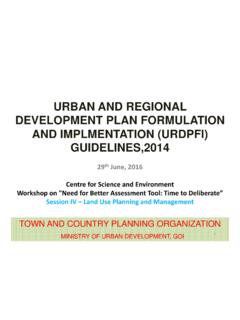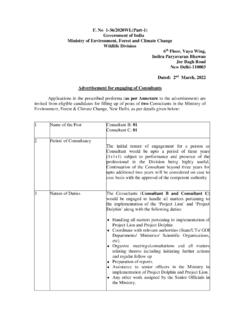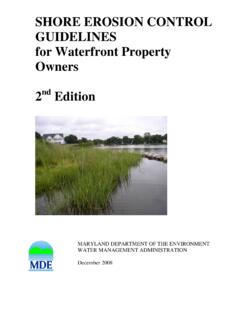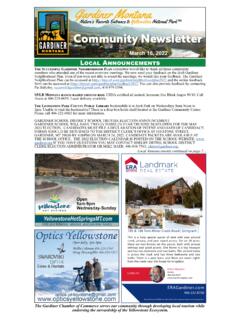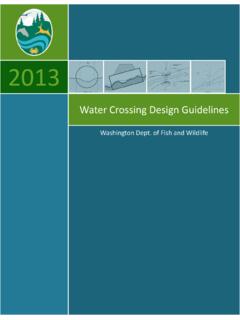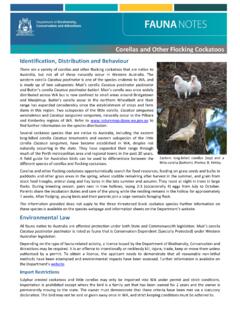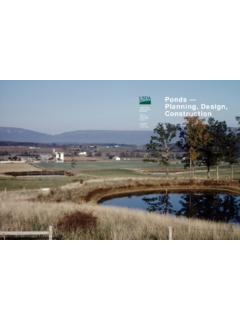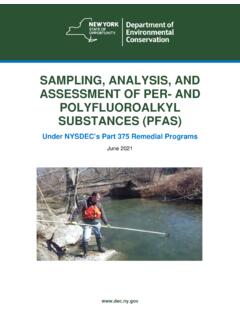Transcription of SAMPLING VEGETATION ATTRIBUTES - USDA
1 SAMPLING VEGETATIONATTRIBUTESINTERAGENCY TECHNICAL REFERENCES upersedes BLM Technical Reference 4400-4, Trend Studies, dated May 1985 Edited, designed, and produced by the Bureau of Land Management sNational Applied Resource Sciences CenterBLM/RS/ST-96/002+1730 SAMPLING VEGETATION AttributesInteragency Technical ReferenceCooperative Extension Department of Agriculture Forest Service Natural Resource Conservation Service,Grazing Land Technology Department of the Interior Bureau of Land Management 1996 Revised in 1997, and 1999 TABLE OF CONTENTSSAMPLING VEGETATION ATTRIBUTESI nteragency Technical ReferenceBy (In alphabetical order)Technical Reference 1734-4copies available fromBureau of Land ManagementNational Business Box 25047 Denver, Colorado 80225-0047 Bill CoulloudonRangeland Management of Land ManagementPhoenix, ArizonaKris Eshelman (deceased)Rangeland Management of Land ManagementReno, NevadaJames GianolaWildhorse and Burro of Land ManagementCarson City, NevadaNed HabichRangeland Management of Land ManagementDenver ColoradoLee HughesEcologistBureau of Land ManagementSt.
2 George, UtahCurt JohnsonRangeland Management Service Region 4 Ogden UtahMike PellantRangeland EcologistBureau of Land ManagementBoise, IdahoPaul PodbornyWildlife BiologistBureau of Land ManagementEly, NevadaAllen RasmussenRangeland Management Extension ServiceUtah State UniversityLogan, UTBen RoblesWildlife BiologistBureau of Land ManagementSafford, ArizonaPat ShaverNatural Resource Conservation ServiceRangeland Management , OregonJohn SpeharRangeland Management of Land ManagementRawlins, WyomingJohn WilloughbyState BiologistBureau of Land ManagementSacramento, CaliforniaTABLE OF CONTENTSTABLE OF CONTENTSPageI.
3 PREFACE ..iII. INTRODUCTION ..1A. Terms and Concepts .. 1B. Techniques Not Addressed ..2C. Guidelines ..3D. Location of Study Sites .. 3E. Key Species ..4F. General Observations .. 5G. Coordination ..6H. Electronic Data Recorders ..6I. Reference Areas .. 6 III. STUDY DESIGN AND ANALYSIS .. 7A. Planning the Study .. 8B. Statistical Considerations ..12C. Other Important Considerations .. 22IV. ATTRIBUTES ..23A. Frequency ..23B. Cover .. 25C. Density ..26D. Production .. 27E. Structure ..28F. Composition ..28V. METHODS .. 31A. Photographs .. 31B. Frequency Methods.
4 37C. Dry Weight Rank Method .. 50D. Daubenmire Method ..55E. Line Intercept Method ..64F. Step-Point Method .. 70G. Point-Intercept Method ..78H. Cover Board Method ..86I. Density Method .. 94J. Double-Weight SAMPLING ..102K. Harvest Method .. 112L. Comparative Yield Method .. 116M. Visual Obstruction Method - Robel Pole .. 123N. Other Methods ..130VI. GLOSSARY OF TERMS ..131 VII. REFERENCES .. 139 APPENDIXES ..149 Appendix A Study Location and Documentation Data Form .. 149 Appendix B Study and Photograph Identification ..153 Appendix C Photo Identification Label .. 157 Appendix D Selecting Random Samples (Using Random Number Tables).
5 161 TABLE OF CONTENTSTABLE OF CONTENTS (continued)IllustrationTitlePageNumber1 .. Photo Plot - 3 X 3 Plot Frame Diagram ..342 .. Photo Plot - 5 X 5 Plot Frame Diagram ..353 .. Permanent Photo Plot Location .. 364 .. Frequency Form .. 44-455 .. Nested Frequency Form .. 46-476 .. Frequency Frame .. 487 .. Nested Plot Frame .. 498 .. Dry Weight Rank Form .. 53-549 .. Daubenmire Form .. 59-6010 .. Daubenmire Summary Form .. 61-6211 .. Daubenmire Frame ..6312 .. Line Intercept Form .. 68-6913 .. Cover Data Form .. 75-7614 .. Sample Units (Hits) and Recording Procedures .. 7715 .. Examples of Sighting Devices.
6 8316 .. Examples of Pin Frames .. 8417 .. Example of a Point Frame ..8518 .. Cover Board Method: Density Board Form .. 89-9019 .. Cover Board Method: Profile Board Form .. 91-9220 .. Examples of Cover Boards .. 9321 .. Density Form .. 100-10122 .. Production Form .. 109-11023 .. Weight Estimate Quadrat .. 11124 .. Comparative Yield Form .. 121-12225 .. Robel Pole Form .. 127-12826 .. Robel Pole .. 129iPREFACEDEDICATIONThis publication is dedicated to the memory of Kristen R. Eshelman, whocontributed tremendously to its development and preparation. Through-out his career, Kris was instrumental in producing numerous technicalreferences outlining procedures for rangeland inventory, monitoring, andthe evaluation of rangeland data.
7 Through his efforts, resource specialistswere provided with the tools to improve the public rangelands for thebenefit of rangeland users and the American PREFACEThe intent of this interagency monitoring guide is to provide the basis for consistent,uniform, and standard VEGETATION attribute SAMPLING that is economical, repeatable,statistically reliable, and technically adequate. While this guide is not all inclusive, it doesinclude the primary SAMPLING methods used across the West. An omission of a particularsampling method does not mean that the method is not valid in specific locations; it simplymeans that it is not widely used or recognized throughout the western states.
8 (See , Other Methods.)Proper use and management of our rangeland resources has created a demand for uniformityand consistency in rangeland health measurement methods. As a result of this interest, theUSDI Bureau of Land Management (BLM) and usda Forest Service met in late 1992 andagreed to establish an interagency technical team to jointly oversee the development andpublishing of VEGETATION SAMPLING field 13-member team currently includes representatives from the Forest Service, BLM, theGrazing Land Technology Institute of the Natural Resource Conservation Service (NRCS),and the Cooperative Extension interagency technical team first met in January 1994 to evaluate the existing rangelandmonitoring techniques described in BLM s Trend Studies, Technical Reference TR 4400-4.
9 Theteam spent 2 years reviewing, modifying, adding to, and eliminating techniques for thisinteragency SAMPLING VEGETATION ATTRIBUTES technical reference. Feedback from numerousreviewers, including field personnel, resulted in further INTRODUCTIONI dentifying the appropriate SAMPLING technique first requires the identification of the propervegetation characteristic or attribute to measure. To do this the examiner must considerobjectives, life form (grass, forb, shrub, or tree), distribution patterns of individuals of aspecies, distribution patterns between species (community mosaic pattern), efficiency of datacollection from an economic standpoint, and accuracy and precision of the , lessees, other rangeland users, and interested publics should be consulted andencouraged to participate in the collection and analysis of monitoring data.
10 Those individualsor groups interested in helping to collect data should be trained in the technique used in thespecific management document deals with the collection of VEGETATION data. The interpretation of that datawill be addressed in other documents. This document does not address interpreting vegeta-tion data for adjusting livestock numbers or making other management Terms and Concepts The following terms require an expanded discussionbeyond the scope of the Glossary of Terms:1. Inventory Inventory is the systematic acquisition and analysis of informationneeded to describe, characterize, or quantify VEGETATION .










